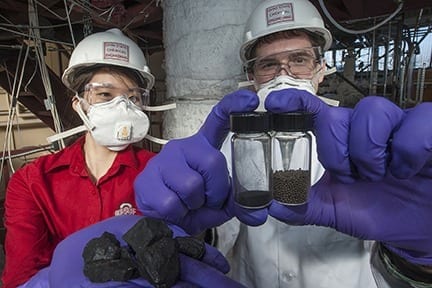
For 203 continuous hours, the Ohio State combustion unit produced heat from coal while capturing 99 percent of the carbon dioxide produced in the reaction.
The technology is now ready for testing at a larger scale.
Liang-Shih Fan, professor of chemical and biomolecular engineering and director of Ohio State’s Clean Coal Research Laboratory,pioneered the technology called Coal-Direct Chemical Looping (CDCL), which chemically harnesses coal’s energy and efficiently contains the carbon dioxide produced before it can be released into the atmosphere.
“In the simplest sense, combustion is a chemical reaction that consumes oxygen and produces heat,” Fan said. “Unfortunately, it also produces carbon dioxide, which is difficult to capture and bad for the environment. So we found a way to release the heat without burning. We carefully control the chemical reaction so that the coal never burns—it is consumed chemically, and the carbon dioxide is entirely contained inside the reactor.”
Dawei Wang, a research associate and one of the group’s team leaders, described the technology’s potential benefits. “The commercial-scale CDCL plant could really promote our energy independence. Not only can we use America’s natural resources such as Ohio coal, but we can keep our air clean and spur the economy with jobs,” he said.
Though other laboratories around the world are trying to develop similar technology to directly convert coal to electricity, Fan’s lab is unique in the way it processes fossil fuels. The Ohio State group typically studies coal in the two forms that are already commonly available to the power industry: crushed coal “feedstock,” and coal-derived syngas.
The latter fuel has been successfully studied in a second sub-pilot research-scale unit, through a similar process called Syngas Chemical Looping (SCL). Both units are located in a building on Ohio State’s Columbus campus, and each is contained in a 25-foot-high insulated metal cylinder that resembles a very tall home water heater tank.
No other lab has continuously operated a coal-direct chemical looping unit as long as the Ohio State lab did last September. But as doctoral student Elena Chung explained, the experiment could have continued.
“We voluntarily chose to stop the unit. We actually could have run longer, but honestly, it was a mutual decision by Dr. Fan and the students. It was a long and tiring week where we all shared shifts,” she said.
Fan agreed that the nine-day experiment was a success. “In the two years we’ve been running the sub-pilot plants, our CDCL and SCL units have achieved a combined 830 operating hours, which clearly demonstrates the reliability and operability of our design,” he said.
At any one time, the units each produce about 25 thermal kilowatts—that is, thermal energy, which in a full-scale power plant would be used to heat water and turn the steam-powered turbines that create electricity.
The Latest Streaming News: Coal Technology updated minute-by-minute
Bookmark this page and come back often
Latest NEWS
Latest VIDEO







